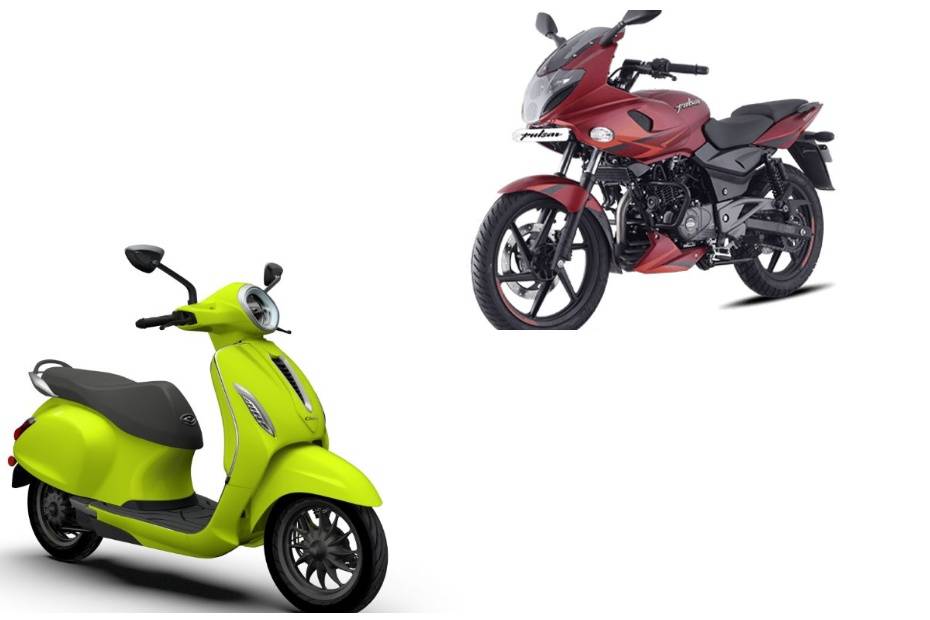Family Feud: Bajaj Chetak vs Pulsar 220F
Modified On Jan 17, 2020 10:03 AM By Zaran Modyfor Bajaj Chetak
- 548 Views
- Write a comment
The raging battle between electric power and internal combustion

Rather annoyingly, I must start this article with a disclaimer. You see, the Bajaj Chetak and the Pulsar 220F can’t exactly be bought from the same showroom: the Chetak will be sold through ProBiking (KTM) dealerships while the Pulsar is placed in your ‘normal’ Bajaj showrooms. That being said, even though the Chetak doesn’t actually carry a Bajaj badge anywhere on it, these two vehicles are still built on the same grounds by the same company. So they are technically from the same family.
Now that we’ve got that out of the way, let’s dive in. The Premium variant of the Chetak costs Rs 1.15 lakh while the 220F sells for Rs 1.08 lakh. This is 2020 and environmental awareness is not just hip, it is a necessity, so what should you buy? A futuristic, feature-rich and environmentally friendly electric scooter, or a performance-oriented petrol motorcycle that’s been around for over a decade? Let’s take a look:
Design

This feels a lot like apples and oranges - comparing the looks of a motorcycle and a scooter. Despite remaining almost unchanged since 2009, the Pulsar 220F still looks smart for its age. Its half fairing and projector headlights look quite striking in your mirrors, and the once Pulsar-defining twin strip tail-lamps are still present on this 220F. The meaty exhaust end-can looks very attractive and goes well with the butch overall design.
But at the end of the day, it’s the Chetak that’s the more attractive looking vehicle, at least to my eyes. Yes, it’s just a scooter, but its design is cohesive and extremely well executed. The sculpted body panels look great, panel gaps are tight and consistent and the neo-retro theme has been pulled off well. Sure, it does look remarkably similar to the current Vespa range, but considering that the old Chetak and the old Vespas looked alike as well, this isn’t too much of a surprise.
Also Read: Bajaj Chetak Urbane Electric Scooter: Same Price, Other Options
Specs

This is a segment where the Pulsar completely walks over the Chetak. The scooter’s 4kW, 16Nm motor and 60kmph top speed are no match for the Pulsar’s 220cc, 20.93PS, 18.55Nm engine. And while the 95km of range is quite commendable for an electric scooter, it still pales in comparison to the 500+km that the 220 can manage on a tankful.
Also, while the Chetak has to make do with a trailing-link front suspension setup and 12-inch wheels, the Pulsar gets a telescopic front fork and 17-inch rims at both ends. It also gets a larger front brake disc than the scooter, but this is necessary, since at 155kg, it is 35kg heavier than the Chetak.
Features

The Chetak, being a decade newer than the Pulsar and designed with a futuristic outlook, claws back lost ground in this area of the comparison. It’s packed with quite a lot of features including a fully digital instrument cluster with Bluetooth connectivity, a reverse gear, LED lighting, USB charging, regenerative braking and feather-touch switches.
The only items populating the Pulsar’s feature list are a semi-digital instrument cluster, LED tail-lamp and single-channel ABS.
Verdict

It’s quite apparent that these two vehicles are vastly different in terms of design, purpose and appeal. So it’s only logical that they’ll attract two very different sorts of buyers as well. If you’re someone who places performance on a pedestal and is looking for a sporty motorcycling experience, it’s obvious that the Chetak’s mundane top-speed figure isn’t going to keep you happy, and so the Pulsar is obviously the choice for you.

But if all you need is something to get you to the office and back every day and ferry you on your weekly shopping run, the Chetak is the perfect companion. It’s quiet, vibe free, largely maintenance-free and offers storage space, making it a far more convenient vehicle to own and ride on a daily basis.
